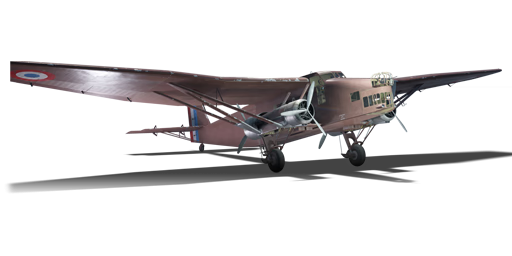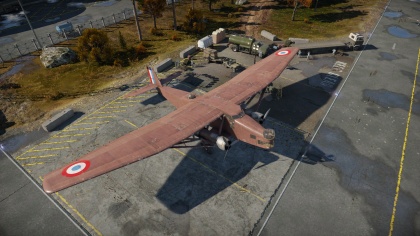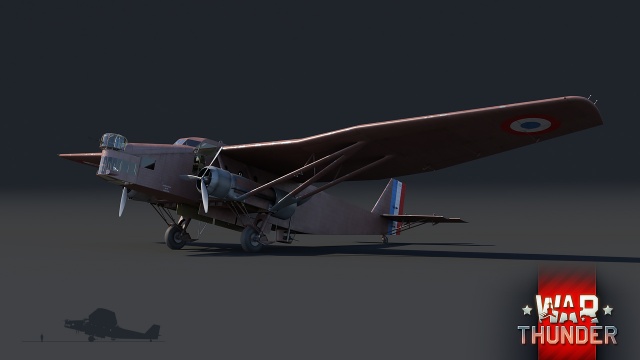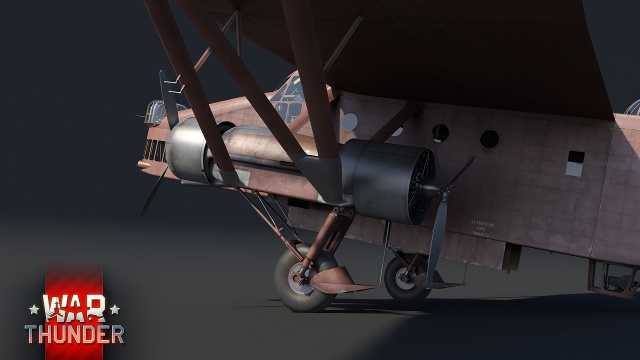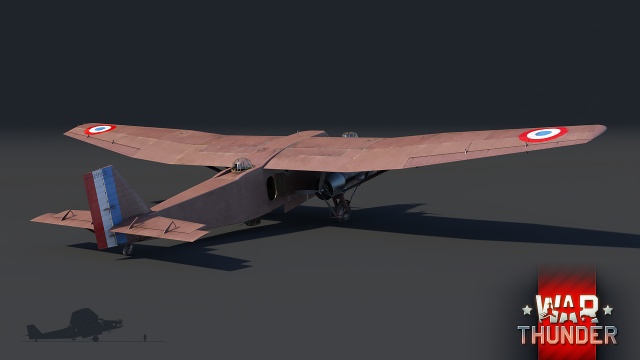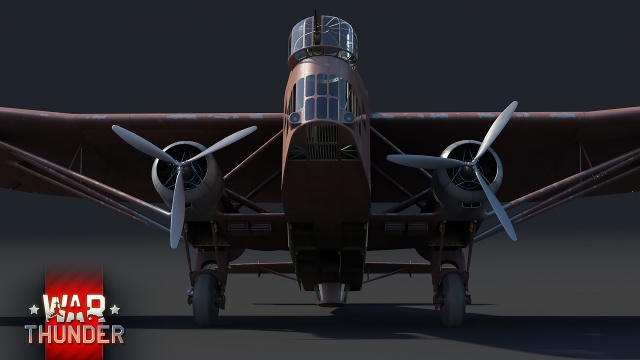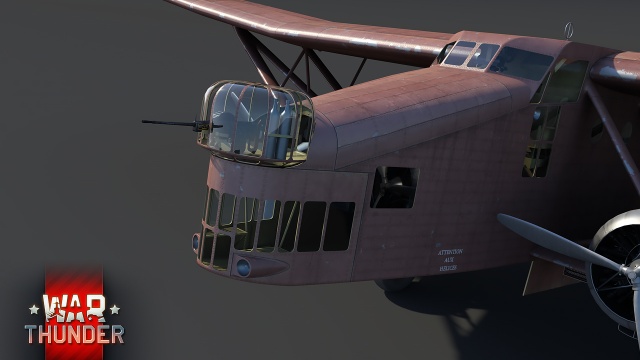F.222.2
Contents
Description
The F.222.2 is a Rank I French bomber
with a battle rating of 1.7 (AB), 2.3 (RB), and 1.3 (SB). This bomber was introduced in Update 1.73 "Vive la France".
The Farman F.222.2 is the first French bomber in the tech tree lineup. Most nations in War Thunder start with small to medium two-engined bombers which can drop a few bombs, and the Italians step it up with a three-engined S.81 bomber; however, this does not come close to the French. To dominate the early ground-pounding scene, the F.222.2 shows up as the biggest, heaviest, least manoeuvrable and hardest hitting bomber early in the game at a measly battle rating of 1.7. This massive bomber’s empty weight is more substantial than the Italian S.81’s loaded weight!
The F.222.2 features a parasol wing setup with four radial engines set up in a push-pull configuration. This engine setup allows the pulling engines to turbocharge the wind passing through the pushing engines adding needed horsepower, this also, unfortunately, concentrates the engines into close quarters making it easier for enemy fighters to hit them. While this aircraft has the potential to soak up a lot of 7.5 mm bullets (even some 20 mm) the wings potentially provide an Achilles heel of the aircraft. Each wing contains eight massive fuel tanks which do not self-seal when hit and are prone to catch on fire. A burning F.222.2 will not last long before structural fatigue sets in and the wings buckle.
While a huge target for incoming fighters to attack, the F.222.2 is not without any defences. This bomber is protected by three turrets, one ventral, one dorsal and one in the nose. All three turrets feature a single Darne Mle 33 7.5 mm machine gun, which may not seem like much, but against small fighter aircraft which lack any armour, chances are the gunners will rupture the fighter’s engine, oil coolers, water coolers, fuel tanks or even incapacitate the pilot lending to an aerial victory. Fighters looking for a fast and “free-kill” when going after the F.222.2 should think twice before just rumbling up on the bomber’s doorstep as they may find themselves on a one-way trip to the ground in a heap.
The massive F.222.2 has one purpose, and that is to drop bombs, lots of bombs! This massive aircraft initially carries 52 x 50 kg bombs however later upgrades will include 100 kg, 200 kg and 500 kg bombs, maxing the payload out at 2,700 kg! Payloads this size can take out columns of vehicles and even in up-tiered situations can do massive damage against enemy bases. This bomber works best at lower altitudes such as between 100 and 500 m, but this beast is nimble enough to bomb targets from as low as 50 m off of the deck. This huge bomber can be a bit frustrating at first, but as newer modules are unlocked and added, the aircraft can take more damage, and it can be surprising how long it survives even though it is full of holes and is trailing smoke from several of its surfaces.
General info
Flight Performance
| Characteristics | ||||||||
|---|---|---|---|---|---|---|---|---|
| Condition | Max Speed (km/h at 3,400 m) |
Max altitude (meters) |
Turn time (seconds) |
Rate of climb (meters/second) |
Take-off run (meters) | |||
| AB | RB | AB | RB | AB | RB | |||
| Stock | 385 | 366 | 6200 | 31.8 | 33.0 | 11.1 | 6.4 | 750 |
| Upgraded | 383 | 366 | 31.2 | 33.0 | 9.3 | 6.4 | ||
Details
| Features | ||||
|---|---|---|---|---|
| Combat flap | Take-off flap | Landing flap | Air brakes | Arrestor gear |
| X | X | X | X | X |
| Limits | ||||
|---|---|---|---|---|
| Wing-break speed (km/h) |
Gear limit (km/h) |
Combat flap (km/h) |
Max Static G | |
| + | - | |||
| 0 | 450 | ??? | ~?? | ~? |
| Optimal velocities | |||
|---|---|---|---|
| Ailerons (km/h) |
Rudder (km/h) |
Elevators (km/h) |
Radiator (km/h) |
| < ??? | < ??? | < ??? | > ??? |
| Compressor (RB/SB) | ||
|---|---|---|
| Setting 1 | ||
| Optimal altitude | 100% Engine power | WEP Engine power |
| ?,??? m | ??? hp | ?,??? hp |
Survivability and armour
- No armour plating
- No armour glazing
- Vulnerable fuel tanks in the wings
- Huge aircraft, slow and large target
Armaments
Suspended armament
The F.222.2 can be outfitted with the following ordinance:
- 52 x 50 kg G.A.M.Mn 50 bombs (total = 2,600 kg)
- 7 x 100 kg №.1 bombs + 5 x 200 kg №.1 bombs (total = 1,700 kg)
- 4 x 500 kg №.2 bombs (total = 2,000 kg)
- 7 x 100 kg №.1 bombs + 10 x 200 kg №.1 bombs (total = 2,700 kg)
Game style will change depending on the type of bomb payload chosen. For usage on early maps with out bases, the 52 G.A.M.Mn bombs will be the payload of choice. These small bombs used from a low altitude provide a scatter effect where they can be dropped in column runs allowing for convoys of vehicles or multiple cluster sites of artillary to be bombed in one run. Utilising the 50 kg bombs from higher altitudes against vehicles is discouraged as they tend to scatter out of the effective explosive range of the bombs by the time they get to the ground. Low bombing runs against vehicles hits them before they have time to scatter.
Conversly, the larger bombs tend to be less effective against small vehicle targets especially from highter altitudes which give them time to scatter and move out of the effective explosive range. The 100, 200 and 500 kg bombs are very effective against stationary and hardened targets such as AAA sites, pillboxes and bases. Base bombing is very effective from higher altitudes espeically if there is fighter escort which will help provide the bomber time to get to the site and drop its payload.
Defensive armament
The F.222.2 is armed with:
- 1 x 7.5 mm Mle 33 machine gun, nose turret (1,000 rpg = 1,000 total)
- 1 x 7.5 mm Mle 33 machine gun, dorsal turret (720 rpg = 720 total)
- 1 x 7.5 mm Mle 33 machine gun, ventral turret (720 rpg = 720 total)
The F.222.2 has decent turret coverage when it comes to defences. With one turret in the nose of the aircraft and the other two located at the dorsal and ventral positions the bomber is capable of defending itself from attacks. Early fighters typically do not have any armor protection and if they approach from the rear of the aircraft are likely to take critcal damage. Be aware of fighters approaching from the side where there are more blind spots as from here they will be targeting either the engines or the wings which contain huge fuel tanks. Do not be afraid to chase or saddle up next to enemy fighters giving the turret gunners a chance to unload on the fighters and potentially score an aerial victory.
Usage in the battles
The F.222.2 is a heavy hitting bomber with okay maneuverability at low altitude and low air speed, and can carry a staggering 52x50 kg bombs while still in stock configuration. Combined with its frequent presence in Ground Strike matches with only light vehicles, it will make short work of any (or even all) groups of armored cars and SPAA it crosses paths with, and can demolish an opposing team's entire complement of AAA and artillery in short order.
Additionally, the ability to carry larger bomb loads later in its upgrade tree turns it into an exceptionally capable base killer, often time wiping out bases solo without sacrificing its heavy-hitting power against armored columns. With some skill (and an escort from friendly fighters), the F.222.2 can wipe out an entire column of medium tank AI targets in a single pass, with enough firepower left over to seriously cripple another column.
It is important to match the altitude flown with the payload type chosen as lower altitudes (100 - 500 m or even lower) when utilising the 50 kg bombs against moving targets where as higher altitudes are preferred when utilising larger ordinance against stationary targets. On maps where controlling an airfield is key, do not be afraid to "carpet bomb" the runway to prevent enemy aircraft from taking over the airfield or out-right destroy those which have landed. Be aware of friendly aircraft which may also be on the runway as the bombs don't descriminate who they damage/destroy.
Manual Engine Control
| MEC elements | ||||||
|---|---|---|---|---|---|---|
| Mixer | Pitch | Radiator | Supercharger | Turbocharger | ||
| Oil | Water | Type | ||||
| Not controllable | Controllable Automatic pitch |
Controllable | Not controllable | Combined | Controllable | Not controllable |
Modules
| Tier | Flight performance | Survivability | Weaponry | ||
|---|---|---|---|---|---|
| I | Fuselage Repair | Radiator | Offensive 7 mm | ||
| II | Compressor | Airframe | 200 GPs | ||
| III | Wings Repair | Engine | New 7 mm MGs (turret) | 500 GPs | |
| IV | Engine Injection | Cover | 200 GPs S5 | ||
Pros and cons
Pros:
- Impressive bomb load
- Different bomb options make this bomber very versatile
- Fuselage can absorb a lot of damage
- Once at altitude, it can be difficult to reach for reserve planes
Cons:
- Incredibly slow and very heavy
- Engines are very vulnerable to enemy weapons
- Slow speed, heavy weight, and no takeoff flaps makes taking off when fully loaded very difficult
- High repair cost for a rank 1 bomber
- Long take off distance
- Vulnerable to fast climbing, well armed aircraft like the Mig 3
- Armament is slightly underwhelming for such a large aircraft
History
Describe the history of the creation and combat usage of the aircraft in more detail than in the introduction. If the historical reference turns out to be too big, take it to a separate article, taking a link to an article about the vehicle and adding a block "/ historical reference" (example: https://wiki.warthunder.com/Name-vehicles/historical reference) and add a link to it here using the main template. Be sure to include links to sources at the end of the article.
Media
Read also
Links to the articles on the War Thunder Wiki that you think will be useful for the reader, for example,
- reference to the series of the aircraft;
- links to approximate analogues of other nations and research trees.
Sources
- War Thunder News - 5047 - Farman F.222.2 Big! Heavy! Yours!
- page on aircraft encyclopedia;
- other literature.
| France bombers | |
|---|---|
| Farman | F.222.2 · N.C.223.3 |
| Latécoère | Late 298D |
| Potez | Potez 633 |
| Liore et Olivier | LeO 451 early · LeO 451 late |
| Bloch | M.B.174A-3 · M.B.162 · M.B.175T |
| American | V-156-F · Martin 167-A3 · ▄A-35B · ▄SB2C-5 · B-26C · ▄PBY-5A Late · ▄PB4Y-2 |
| British | Lancaster MR.7 |


